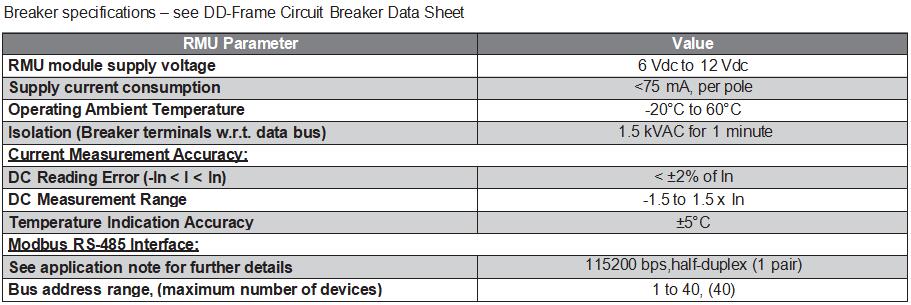The RMU is a DD-Frame circuit breaker factory fitted with a remote monitoring unit (RMU) that measures the current flow and the circuit breaker’s condition, and communicates the information via a RS-485 serial bus. It enables the host system to monitor current usage and ON / OFF / Tripped contact status. The unit has an active health monitor for condition based maintenance, with the number of operations stored to memory (on-load, no-load and overload operations combined with operating conditions). Along with a readout of manufacturing information, each device has a unique ID number for traceability. It has RGB status LEDs, visible at the top and bottom, configurable for various status displays.
The RMU circuit breaker current range is from 3 A to 100 A on a single pole, up to 200 A on a double pole and up to
300 A on a three pole. The plug-in terminals are suitable for a hot-pluggable busbar style panel that includes a PCB strip with data connectors. The RMU modules self-identify their positions on the bus, based on a simple resistor scheme. The breaker footprint allows the panel to be backwards compatible with DD-Frame circuit breakers fitted with trip-alarm auxiliary, so that a panel can accomodate both RMU and standard breakers.
Features
• Intelligent Protection + Monitoring
• Real time status monitoring
• Circuit Breaker status (On, Off, Trip Alarm)
• Current measurement (Amps and direction of flow)
• Diagnostics (overload, temperature, operating hours, switching operation counters)
• Circuit Breaker Health Estimate* (percentage remaining life, based on operating conditions)
• LED indication of circuit breaker status. Visible top and bottom.
Configurable color scheme for RGB LED
• Automatic lamp test sequence while powering on
• Circuit breaker digital Information
Unique 64-bit ID for inventory traceability
• Current rating (and number of paralleled poles)
• Manufacturing date
• Ordering information
• Modbus over RS-485 data bus, up to 40 breakers on one serial bus
• Rear plug-in data terminal for simplified back-plane design
• Hot-swappable – inserted breakers self-identify on data bus
Applications
• Telecoms
• Dark Data Centers
• Digital Twin
• Condition Based Maintenance
• Energy optimisation
• Battery management







